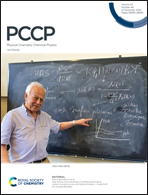Probing the electronic structure and hydride occupancy in barium titanium oxyhydride through DFT-assisted solid-state NMR†
Abstract
Perovskite-type oxhydrides such as BaTiO3−xHy exhibit mixed hydride ion and electron conduction and are an attractive class of materials for developing energy storage devices. However, the underlying mechanism of electric conductivity and its relation to the composition of the material remains unclear. Here we report detailed insights into the hydride local environment, the electronic structure and hydride conduction dynamics of barium titanium oxyhydride. We demonstrate that DFT-assisted solid-state NMR is an excellent tool for differentiating between the different feasible electronic structures in these solids. Our results indicate that upon reduction of BaTiO3 the introduced electrons are delocalized among all Ti atoms forming a bandstate. Furthermore, each vacated anion site is reoccupied by at most a single hydride, or else remains vacant. This single occupied bandstate structure persists at different hydrogen concentrations (y = 0.13–0.31) and a wide range of temperatures (∼100–300 K).

- This article is part of the themed collection: 2022 PCCP HOT Articles


 Please wait while we load your content...
Please wait while we load your content...